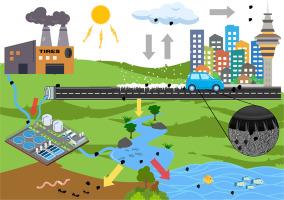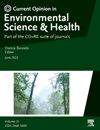轮胎磨损颗粒和与轮胎相关的新兴污染物:特征、发生和环境中的毒性
IF 6.6
Q1 ENVIRONMENTAL SCIENCES
Current Opinion in Environmental Science and Health
Pub Date : 2025-09-08
DOI:10.1016/j.coesh.2025.100666
引用次数: 0
摘要
作为一种常见轮胎抗氧化剂的有毒转化产物和含水污染物,6ppd -醌的发现催化了对其环境发生和其他与轮胎相关的新兴污染物(trec)的广泛研究。然而,许多其他轮胎衍生的化学品仍未得到充分研究,但可能会造成重大的环境风险。本文综述了trec的特征、发生和命运,以及它们的毒理学影响。虽然分析技术的进步加强了对这些污染物的检测,但在各种环境隔间中,它们的持久性、转化和长期影响方面存在知识空白。最近的研究结果表明,在道路径流、废水、沉积物甚至生物群中经常检测到几种trec,包括二苯基胍(DPG)和六聚甲氧基甲基三聚氰胺(HMMM)。鉴于它们的广泛存在和潜在毒性,迫切需要进一步调查它们的环境行为、监管影响和缓解策略。本综述强调,迫切需要扩大6ppd -醌以外的研究,以解决与trec相关的更广泛的风险。本文章由计算机程序翻译,如有差异,请以英文原文为准。

Tire-wear particles and tire-related emerging contaminants: Characteristics, occurrence, and toxicity in the environment
The discovery of 6PPD-quinone as a toxic transformation product and aqueous contaminant from a common tire antioxidant has catalyzed extensive research into its environmental occurrence and other tire-related emerging contaminants (TRECs). However, many other tire-derived chemicals remain understudied, yet may pose significant environmental risks. This review provides a critical overview of the characteristics, occurrence, and fate of TRECs, as well as their toxicological impacts. While advancements in analytical techniques have enhanced the detection of these contaminants, knowledge gaps exist regarding their persistence, transformation, and long-term effects in various environmental compartments. Recent findings suggest that several TRECs, including diphenylguanidine (DPG) and hexamethoxymethylmelamine (HMMM), are frequently detected in road runoff, wastewater, sediments, and even biota. Given their widespread occurrence and potential toxicity, further investigations into their environmental behavior, regulatory implications, and mitigation strategies are urgently needed. This review highlights the pressing need for expanded research beyond 6PPD-quinone to address the broader risks associated with TRECs.
求助全文
通过发布文献求助,成功后即可免费获取论文全文。
去求助
来源期刊

Current Opinion in Environmental Science and Health
Medicine-Public Health, Environmental and Occupational Health
CiteScore
14.90
自引率
0.00%
发文量
92
审稿时长
114 days
 求助内容:
求助内容: 应助结果提醒方式:
应助结果提醒方式:


